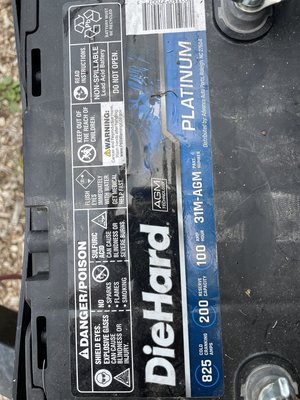Scotsman
RVF Regular
- Joined
- Aug 12, 2021
- Messages
- 23
- Location
- WY - Wyoming
- RV Year
- 2001
- RV Make
- Casita
- RV Model
- Legacy
- RV Length
- 16 LOA
- TOW/TOAD
- Ford F150 2.7
- Fulltimer
- No
Hey solar gurus - my so-simple solar charging system is driving me nuts. It's got three components 1) a 100W solar panel 2) A Renogy Voyager 20A controller 3) A new and unused Die Hard 100Ah battery (with a reserve capacity of 200?), And of course the wires - which run outside the camper. The cables from the controller to the battery are 20" long. Oh - and I have a back-up briefcase - 80 Watt with it's own controller.
Questions:
1) I wanted to test the charging power of the solar panel with the new battery - so ran the battery down to 11.8V (It started at 13.1V - which I achieved from a 3-stage charger).
First of all - is that 11.8 Volts minimum the target below which I shouldn't go in order to preserve battery life? The battery doesn't say what the 200 of reserve capacity is - not Amps or Amp-hours or jelly beans - it just says 200 reserve. What does this reserve mean? - and how does it affect, if at all the 11.8 volt low bar, as mentioned, or the general service the battery should give me?
2) Starting to charge the battery with solar panel, the information on the monitor runs from a) Battery Voltage 2) Charging Amps 3)KWh On sunny day with partial clouds and some smoke haze - but I'd say 80% solar getting through cos I got a bit burned out there - the Amps reading fluctuated between 0.3 and 2.8. The battery has taken several hours to charge from 11.8 to 12.2. What should the ideal Amps reading be - something like 20?
3) The panel is clean and worked well for me in previous summers - I look after my solar panel, cover it in winter and the whole thing, and cables are in generally great order. The voltage readings are backed-up with a multimeter.
4) I have eliminated controller issues as I tested it with the controller from the suitcase...same results
5) I sometimes add the briefcase panel to the system simply by adding it to the relevant battery terminals - rather than trying to ad the two panels in series. So I have two controller attached by short wires to the battery terminals. I wonder if the controllers interfere or compete with each other and create internal damage on at least one of them? The voltage readings remain accurate.
Whew - that's a lot - but thanks for any advice.
Questions:
1) I wanted to test the charging power of the solar panel with the new battery - so ran the battery down to 11.8V (It started at 13.1V - which I achieved from a 3-stage charger).
First of all - is that 11.8 Volts minimum the target below which I shouldn't go in order to preserve battery life? The battery doesn't say what the 200 of reserve capacity is - not Amps or Amp-hours or jelly beans - it just says 200 reserve. What does this reserve mean? - and how does it affect, if at all the 11.8 volt low bar, as mentioned, or the general service the battery should give me?
2) Starting to charge the battery with solar panel, the information on the monitor runs from a) Battery Voltage 2) Charging Amps 3)KWh On sunny day with partial clouds and some smoke haze - but I'd say 80% solar getting through cos I got a bit burned out there - the Amps reading fluctuated between 0.3 and 2.8. The battery has taken several hours to charge from 11.8 to 12.2. What should the ideal Amps reading be - something like 20?
3) The panel is clean and worked well for me in previous summers - I look after my solar panel, cover it in winter and the whole thing, and cables are in generally great order. The voltage readings are backed-up with a multimeter.
4) I have eliminated controller issues as I tested it with the controller from the suitcase...same results
5) I sometimes add the briefcase panel to the system simply by adding it to the relevant battery terminals - rather than trying to ad the two panels in series. So I have two controller attached by short wires to the battery terminals. I wonder if the controllers interfere or compete with each other and create internal damage on at least one of them? The voltage readings remain accurate.
Whew - that's a lot - but thanks for any advice.













